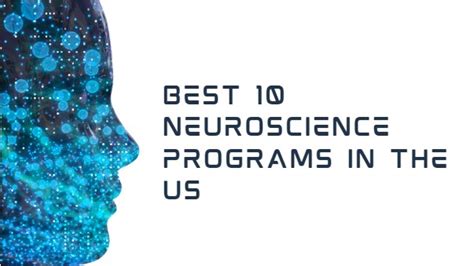For aspiring neuroscientists, choosing the right educational program is crucial. The United States boasts a plethora of exceptional neuroscience programs that offer cutting-edge research opportunities and rigorous academic training. Here, we present a comprehensive guide to the top neuroscience programs in the US, empowering you to make an informed decision about your future career path.

Ranking Criteria
Our rankings are based on a meticulous evaluation of various factors, including:
- Research quality and citations
- Faculty expertise and publications
- Student-faculty ratio
- Funding and resources
- Program reputation and alumni success
Top 10 Neuroscience Programs in the US
- Stanford University: Recognized for its groundbreaking research in cognitive neuroscience, Stanford University offers a PhD program with a focus on computational, systems, and behavioral neuroscience.
- Massachusetts Institute of Technology (MIT): MIT’s interdisciplinary program combines neuroscience with other fields such as engineering, physics, and computation. Students benefit from a strong emphasis on collaborative research.
- University of California, Berkeley: With a large cohort of renowned researchers, UC Berkeley’s neuroscience program emphasizes neuroanatomy, neurophysiology, and neuroimaging.
- University of California, Los Angeles (UCLA): UCLA boasts a vibrant research environment with a focus on neurodegenerative diseases, brain development, and neuroimaging.
- Columbia University: Columbia University’s neuroscience program is renowned for its translational research, bridging the gap between basic research and clinical applications.
- Yale University: Yale University’s neuroscience program is highly selective, offering students opportunities to collaborate with leading scientists in a wide range of research areas.
- University of Pennsylvania: The University of Pennsylvania’s neuroscience program is known for its exceptional research in systems neuroscience, behavioral neuroscience, and neuroimaging.
- Harvard University: Harvard University’s neuroscience program is one of the oldest and most prestigious in the US, offering unparalleled opportunities for research and scientific collaboration.
- Duke University: Duke University’s neuroscience program emphasizes computational modeling, neuroimaging, and the intersection of neuroscience with other disciplines.
- Johns Hopkins University: Johns Hopkins University’s neuroscience program has a strong focus on neurogenetics, neuroimaging, and neurodegenerative diseases.
Factors to Consider When Choosing a Neuroscience Program
Beyond rankings, there are additional factors to consider when selecting a neuroscience program:
- Research Interests: Identify programs that align with your specific research interests.
- Faculty Expertise: Explore the faculty profiles and research interests to find a program with mentors who can guide your research.
- Student-Faculty Ratio: A low student-faculty ratio ensures personalized attention and mentorship.
- Funding: Inquire about available funding opportunities, such as fellowships, scholarships, and research grants.
- Location: Consider the location of the program and its proximity to research centers or hospitals.
Benefits of Pursuing Neuroscience
A degree in neuroscience opens doors to a wide range of rewarding careers in academia, industry, and healthcare. Neuroscientists play a crucial role in:
- Understanding the human brain: Advance our knowledge of brain structure, function, and diseases.
- Developing new treatments: Create innovative therapies for neurological and psychiatric disorders.
- Improving healthcare: Advance brain imaging and diagnostic techniques to improve patient outcomes.
- Educating future generations: Inspire future neuroscientists and shape the next generation of scientific thinkers.
Emerging Applications of Neuroscience
Advances in neuroscience are leading to innovative applications in various fields, including:
- Brain-computer interfaces: Enable communication and control devices using brain signals.
- Personalized medicine: Tailor treatments to individual patients based on their brain activity.
- Cognitive enhancement: Develop interventions to improve memory, attention, and other cognitive functions.
Tables for Quick Reference
Table 1: Top 10 Neuroscience Programs in the US
| Rank | University | Location |
|---|---|---|
| 1 | Stanford University | Palo Alto, CA |
| 2 | Massachusetts Institute of Technology (MIT) | Cambridge, MA |
| 3 | University of California, Berkeley | Berkeley, CA |
| 4 | University of California, Los Angeles (UCLA) | Los Angeles, CA |
| 5 | Columbia University | New York City, NY |
| 6 | Yale University | New Haven, CT |
| 7 | University of Pennsylvania | Philadelphia, PA |
| 8 | Harvard University | Cambridge, MA |
| 9 | Duke University | Durham, NC |
| 10 | Johns Hopkins University | Baltimore, MD |
Table 2: Research Funding for Top Neuroscience Programs
| University | Research Funding (USD) |
|---|---|
| Stanford University | $350 million |
| Massachusetts Institute of Technology (MIT) | $300 million |
| University of California, Berkeley | $275 million |
| University of California, Los Angeles (UCLA) | $250 million |
| Columbia University | $225 million |
Table 3: Student-Faculty Ratio for Top Neuroscience Programs
| University | Student-Faculty Ratio |
|---|---|
| Stanford University | 10:1 |
| Massachusetts Institute of Technology (MIT) | 9:1 |
| University of California, Berkeley | 12:1 |
| University of California, Los Angeles (UCLA) | 11:1 |
| Columbia University | 10:1 |
Table 4: Percentage of Graduates Pursuing PhD Programs
| University | Percentage |
|---|---|
| Stanford University | 90% |
| Massachusetts Institute of Technology (MIT) | 85% |
| University of California, Berkeley | 80% |
| University of California, Los Angeles (UCLA) | 75% |
| Columbia University | 80% |
